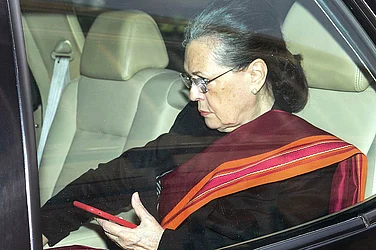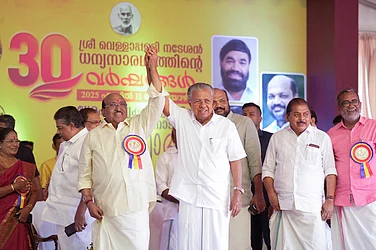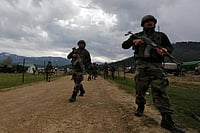For close to three years, the government has had no answer to the ever-growing mountain of surplus foodgrains in its godowns, with state governments unable or even unwilling to lift their allocations. At the same time, starvation deaths were reported from several states, prompting the government to come up with a plan to address the problem of malnutrition in the worst-affected districts of the country. Now, for the first time, financial assistance is being sought from leading Indian corporate houses for a novel food for work programme to be launched by the Central government. The scheme, likely to be announced by the prime minister on Republic Day, also involves a number of NGOs and the World Food Programme (WFP).
The scheme will initially be funded by money from corporate houses. The Union food and civil supplies ministry has already sought and received approval from the Central Board of Direct Taxes to exempt any contributions towards its drive against malnutrition from taxes. A first tranche of around Rs 5 crore is expected before Republic Day. While the list of contributors will be released only after the money is actually received, a senior ministry official says the response from leading industrial houses has been "extremely encouraging".
The food to be distributed is called Indiamix, a nutritious combination of foodgrains, soyabean, micronutrients and vitamins. A mere 80 gm a day is sufficient to prevent malnutrition in children. Likewise, 100 gm a day is adequate for a woman—provided she isn't pregnant or lactating—and 120 gm for an adult male. This is based on calorie intake standards set by the Indian government. Indiamix is intended to complement the public distribution system, which makes subsidised foodgrains available to below-poverty-line consumers but does not fully address the problem of malnutrition, as protein, micronutrient and vitamin deficiencies cannot be addressed on a diet composed exclusively of cereals.
Indiamix has been developed by the WFP and has already been distributed in drought-stricken Rajasthan and among the quake-hit of Gujarat as also the Bhutanese refugees in Nepal. What makes Indiamix an ideal food is that it does not require oil and fat to cook and has been developed keeping local taste in mind. Dieticians and culinary experts at the WFP have developed 21 India-specific recipes for the mix.
The brainchild of Union food and civil supplies minister Sharad Yadav, the new scheme will also provide a mechanism for the Centre to intervene directly in localised outbreaks of famine, instead of depending on the distribution mechanism of the state government and the district administration. The recent blame game between Rajasthan chief minister Ashok Gehlot and New Delhi on drought relief underlined the need for an alternative mechanism, a senior ministry official points out. The idea is to "complement and not replace" the efforts of the state governments, he stresses.
Indiamix, which looks and tastes like flour (it is about three-quarters cereal), can be eaten in various forms. It can be made into rotis, or as gruel mixed with water, or even as a burfi when mixed with sugar. Developed specifically to meet the needs of the Indian population, it was distributed to more than two lakh people under a WFP-sponsored programme following the Gujarat earthquake last year. The feedback was positive, prompting the government to consider using it as part of a wider campaign against malnutrition.
The food supplement is not expensive, provided its constituents aren't imported. Local manufacturers, allowing for a 10 per cent profit, charge Rs 22 per kg. But the food ministry reckons it can pare the costs down to Rs 13.50 per kg, if it pays the manufacturers in kind. For every two or 2.5 kg of foodgrain released from FCI godowns, the manufacturers will give back to the government one kg of Indiamix.
The areas where Indiamix will be distributed under the GOI-WFP scheme will be determined in consultation with the ministry of health and family welfare, which has already furnished data on the country's worst-affected districts. As per the ministry figures, a shocking 25.5 per cent of children in Bihar are classified as severely underweight, and another 54 per cent are moderately underweight. In some districts of the state, like Araria and Kishenganj, malnutrition among children was around 95 per cent, with around half this number being classified as severely undernourished.
Madhya Pradesh is also in bad shape with 24.3 per cent of children overall being classified as severely underweight and 55 per cent as moderately underweight. In Orissa, Rajasthan and UP, the figure for severely underweight children stands at around 20 per cent. Curiously, Andhra Pradesh, which has received a substantial allocation of foodgrains for its food-for-work programme and mid-day meal scheme for children, also has a high proportion of malnutritioned children, with around 10 per cent being classified as severely underweight and 37.7 per cent as moderately underweight, going by National Family Health Survey figures.
Although mooted as a one-time exercise initially, the food ministry has now decided to institutionalise the scheme, give it an all-India character and ensure it runs for at least three successive years to offset the effects of successive drought. It is understood to be preparing a cabinet note requesting the release of 2 million tonnes of foodgrains (from the buffer stock of more than 60 million tonnes) absolutely free of cost for this scheme. Already, free foodgrain is released to state governments under the prime minister's Sampoorna Grameen Rozgaar Yojana, so getting cabinet approval won't be a hurdle. The PMO response has been encouraging, says a senior food ministry official.
Under this scheme, however, the foodgrain will be released to the WFP which will in turn release it to reputed NGOs for distribution. A similar project was successfully undertaken in the drought-hit districts of Baran, Vidisha and Shivpuri by two PSUs—Coal India Limited and the Neyveli Lignite Corporation. They purchased relief material from the FCI and Khadi Gram Udyog and released it to an NGO—the Nehru Yuvak Kendra—for distribution. Usually, the government does not release free or subsidised grain directly to NGOs, hence the WFP's involvement. Corporates will be encouraged to contribute further and the money will be used for meeting overheads like transportation costs.
Another interesting feature of this food-for-work scheme is that the projects undertaken by the target population will relate to water management alone—building of water harvesting facilities, check dams, percolation tanks, etc—all of which will help combat drought in the long term. Feedback from NGOs regarding food-for-work projects indicates that many of them do not create any permanent infrastructure and are undertaken simply to provide work for unemployed villagers—like digging trenches which get filled in or roads which are not maintained and so barely last a season.
If it gets off the ground, the scheme will be a step towards redressing the glaring anomaly of overflowing granaries and starving children, which has repeatedly shown up official apathy in the last three years.
A Morsel Of Sense
The government's brainchild, midwifed by WFP and delivered by corporates and NGOs. That's Indiamix: health food for the poor.

A Morsel Of Sense
A Morsel Of Sense
Published At:
MOST POPULAR
WATCH
MORE FROM THE AUTHOR
×





















